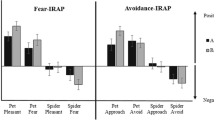Abstract
The current study examined the use of the Implicit Relational Assessment Procedure (IRAP) as a measure of spider fear, approach, and avoidance. Participants were drawn from a normative sample of university undergraduates. Experiment 1employed two IRAPs, one targeting spider fear, the other targeting spider approach/avoidance. The Fear of Spiders Questionnaire (FSQ) and a Behavioral Approach Task (BAT) using a spider moult were also employed. Negative response biases for spider fear and avoidance, but not for approach, were recorded. The bias for fear was significantly stronger than for avoidance and approach. Both IRAP’s failed to provide evidence for the predicative validity of the IRAP in terms of the BAT. Experiment 2 was a partial replication of Experiment 1 but using a live house spider instead of a moult for the BAT. A similar pattern of results was obtained across the two IRAPs, but one specific trial-type (Spider-Approach) predicted approach responses on the BAT. The research, thus, replicated a previously published study by Nicholson and Barnes-Holmes (2012), thus supporting the predictive validity of the IRAP but at a level of precision not provided in the earlier study. Implications for applied research are considered.


Similar content being viewed by others
References
Archer, J. (1997). Why Do People Love Their Pets? Evolution and Human Behavior, 18(4), 237–259.
Augustson, E. M., & Dougher, M. J. (1997). The transfer of avoidance evoking functions through stimulus equivalence classes. Journal of Behavior Therapy and Experimental Psychiatry, 28(3), 181–191.
Barnes-Holmes, D., Barnes-Holmes, Y., Stewart, I., & Boles, S. (2010). A sketch of the Implicit Relational Assessment Procedure (IRAP) and the Relational Elaboration and Coherence (REC) Model. The Psychological Record, 60, 527–542.
Dougher, M. J., Augustson, E., Markham, M. R., Greenway, D. E., & Wulfert, E. (1994). The transfer of respondent eliciting and extinction functions through stimulus equivalence classes. Journal of Experimental Analysis of Behavior, 62(3), 331–351.
Hayes, S. C., Barnes-Holmes, D., & Roche, B. (2001). Relational Frame Theory: A Post Skinnerian Approach to Language and Cognition. New York: Plenum Press.
Hughes, S., Barnes-Holmes, D., & De Houwer, J. (2011). The dominance of associative theorising in implicit attitude research: Propositional and behavioral alternatives. The Psychological Record, 61(3), 465–496.
Hughes, S., Barnes-Holmes, D., & Vahey, N. A. (2012). Holding on to our functional roots when exploring new intellectual islands: A voyage through implicit cognition research. Journal of Contextual Behavioral Science, 1, 17–38.
Hughes, S., De Houwer, J., & Barnes-Holmes, D. (2016). The moderating impact of distal regularities on the effect of stimulus pairings: A novel perspective on evaluative conditioning. Experimental Psychology. (in press)
Hussey, I., & Barnes-Holmes, D. (2012). The Implicit Relational Assessment Procedure as a Measure of Implicit Depression and the role of Psychological Inflexibility. Cognitive and Behavioural Practice, 19, 573–582.
Hussey, I., Barnes-Holmes, D., & Barnes-Holmes, Y. (2015). From relational frame theory to implicit attitudes and back again: Clarifying the link between RFT and IRAP research. Current Opinion in Psychology, 2, 11–15.
Luciano, C., Valdivia-Salas, S., Ruiz, F. J., Rodríguez-Valverde, M., Barnes-Holmes, D., Dougher, M. J., Cabello, F., Sanchez, V., Barnes-Holmes, Y., & Gutierrez, G. (2013). Extinction of aversive conditioned fear: Does it alter avoidant responding? Journal of Contextual Behavioural Science, 2, 120–134.
Luciano, C., Valdivia-Salas, S., Ruiz, F. J., Rodríguez-Valverde, M., Barnes-Holmes, D., Dougher, M. J., Lopez-Lopez, J. C., Barnes-Holmes, Y., & Gutierrez-Martinez, G. (2014). Effects of an Acceptance/Diffusion Intervention on Experimentally Induced Generalised Avoidance: A Laboratory demonstration. Journal of The Experimental Analyses of Behaviour, 101, 94–111.
Nicholson, E., & Barnes-Holmes, D. (2012). The Implicit Relational Assessment Procedure (IRAP) as a measure of spider fear. The Psychological Record, 62, 263–278.
Nicholson, E., Dempsey, K., & Barnes-Holmes, D. (2014). The role of responsibility and threat appraisals in contamination fear and obsessive-compulsive tendencies at the implicit level. Journal of Contextual Behavioural Science, 3(1), 31–37.
Ritzert, T. R., Forsyth, J. P., Berghoff, C. R., Barnes-Holmes, D., & Nicholson, E. (2015). The impact of a cognitive defusion intervention on behavioral and psychological flexibility: An experimental evaluation in a spider fearful non-clinical sample. Journal of Contextual Behavioral Science, 4(2), 112–120.
Roddy, S., Stewart, I., & Barnes-Holmes, D. (2011). Facial reactions reveal that slim is good but fat is not bad: Implicit and explicit measures of body-size bias. European Journal of Social Psychology, 41(6), 688–694.
Smyth, S., Barnes-Holmes, D., & Forsyth, J. P. (2006). A derived transfer of simple discrimination and self-reported arousal functions in spider fearful and non-spider fearful participants. Journal of the Experimental Analyses of Behaviour, 85(2), 223–246.
Szymanski, J., & O’Donohue, W. (1995). Fear of spiders questionnaire. Journal of Behavior Therapy and Experimental Psychiatry, 26(1), 31–34.
Acknowledgments
This article was prepared with the support of an Odysseus Group 1 grant awarded to the second author by the Flanders Science Foundation (FWO) and a doctoral research scholarship awarded to the first author. Correspondence concerning this article should be sent to Aileen.Leech@ugent.be
Author information
Authors and Affiliations
Corresponding author
Ethics declarations
Conflict of Interest
Aileen Leech declares that she has no conflict of interest. Dermot Barnes-Holmes declares that he has no conflict of interest. Lara Madden declares that she has no conflict of interest.
Ethical Approval
All procedures performed in studies involving human participants were in accordance with the ethical standards of the institutional research committee and with the 1964 Helsinki declaration and its later amendments or comparable ethical standards.
Informed Consent
Informed consent was obtained from all individual participants included in the study.
Rights and permissions
About this article
Cite this article
Leech, A., Barnes-Holmes, D. & Madden, L. The Implicit Relational Assessment Procedure (IRAP) as a Measure of Spider Fear, Avoidance, and Approach. Psychol Rec 66, 337–349 (2016). https://doi.org/10.1007/s40732-016-0176-1
Published:
Issue Date:
DOI: https://doi.org/10.1007/s40732-016-0176-1




